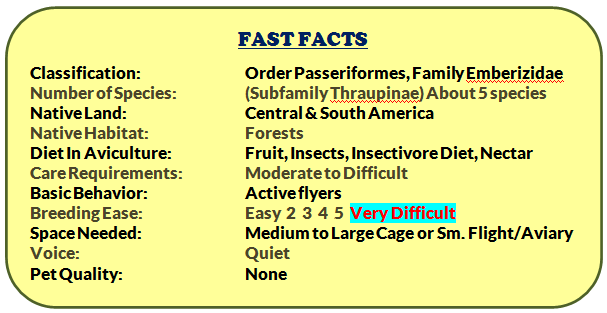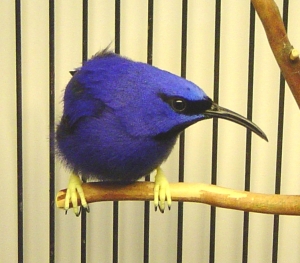
Living Jewels
The tanager family of North and South America boosts some of the most beautiful of all the creatures. Included in the family are honeycreepers or sugarbirds, dacnis, and euphonias. Most tanagers are small, about the size of a sparrow. Many can be kept and bred in mixed species aviaries. The South American jewels, the honeycreepers, are occasionally available, with the Yellow-legged and the Red-legged species the most popular and colorful. There are five species of honeycreepers.
Honeycreepers are smaller than a Zebra Finch, with long, slender bills adapted to sipping nectar from blossoms. None of the honeycreepers can be considered good birds for beginner softbillers as they require a specialized diet and are temperature sensitive. With attention to these two factors though, these birds can prove to be reasonably hardy once acclimated and will even breed in captivity occasionally.
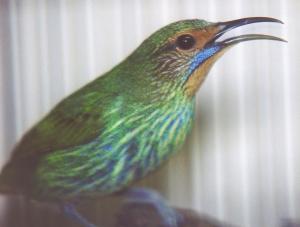
The Red-legged Honeycreeper male has an eclipse plumage and looks like the female when young or not in breeding condition. The male Yellow-legged or Purple Honeycreeper, Cyanerpes caeruleus, is a beautiful bird that keeps his color year-round. Honeycreepers are very active, and both sexes serenade each other with quiet songs. Whether male or female, they can be fatally aggressive if one is ready to breed, and the other is not.
All honeycreepers are sexually dimorphic, although in some species the male will look like the female when not in breeding plumage. The male Purple Honeycreeper is a gorgeous deep bluish-purple while the female is basically green. The females are beautiful birds in their own right with a basic green overall color such as in this female Purple Honeycreeper above. Males have a slightly longer bill also. Juveniles have the female coloration. Although small, honeycreepers can be pugnacious, especially when breeding, and often do better housed by themselves.
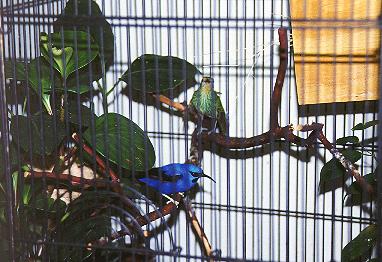
Housing Honeycreepers
They like large, well-planted enclosures, and can be kept in mixed-species aviaries or in flora displays. They are very sensitive to temperature changes and do best indoors. If placed outdoors they should be put in a heated enclosure during cold and winter weather. Honeycreepers have very loose stools, even for a softbill, and will also fling their fruit off their beaks and rub their fruity beaks on the cage and perches to help clean the bill. Perches and cage walls become sticky in very little time. Owners must be vigilant in cleaning the entire cage and perches frequently to lessen the chance of bumblefoot and other bacterial infections. In the house, surrounding walls will get dirty also.
Feeding Honeycreepers
Special attention needs to be paid in feeding these guys, and they are not birds for people that are too busy to spend extra time with them. They cannot eat anything that is too big or too hard. Iron storage disease has been known to affect honeycreepers so the amount of iron in the diet needs to be watched. In the wild, they eat soft fruits, nectar, and small insects. In captivity, they can be fed by taking a finely chopped portion of a basic softbill fruit and vegetable mix, and mixing this, 1:1, with a commercial diet to make a moist crumbly mixture. Brands of commercial diets that can be used are the Universal Food by BEVO, Bugs-N-Berries by Avico (Cuttlebone-Plus), and Lory Special Pellets by Pretty Bird. About one half an ounce of a good quality liquid nectar should be given daily per pair in a separate cup, however nectar is not essential for non-breeding birds. Very small livefood such as white worms, fruit flies, and mini-mealworms should be given at least once a week, although daily when breeding.
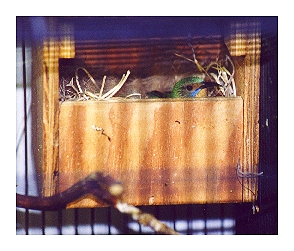
Breeding Honeycreepers
Honeycreepers will breed given privacy, lots of livefood, and preferably a planted aviary. They will build their own cup-shaped nest, use open fronted nestboxes, or sometimes open finch baskets. Cobwebs, rootlets, grasses, and small leaves may be used. Two eggs are laid. Nests are quickly abandoned by the parents if everything is not exactly right, or they are disturbed. Getting chicks to fledging is a difficult task and requires LOTS of livefood and luck!
Honeycreeper Species

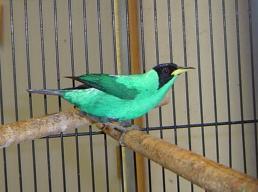
This site presents material for your information, education, and entertainment. All photographs were taken by the Davis Lunds. All photos and text are property of the Davis Lunds.
You may not copy, distribute, modify, reuse, or transmit any portions of this site for commercial or public use without written permission from the Davis Lunds.
No text or photos can be copied for use in other websites, personal or commercial.
Copyright 07/09 Kateri Davis

